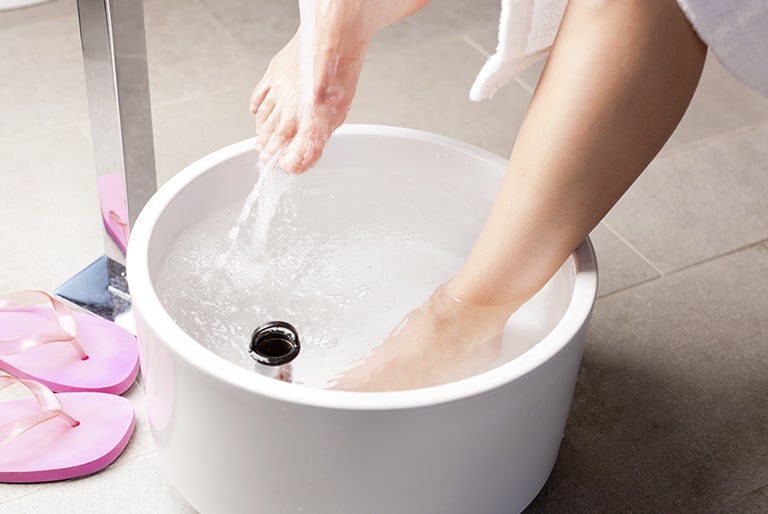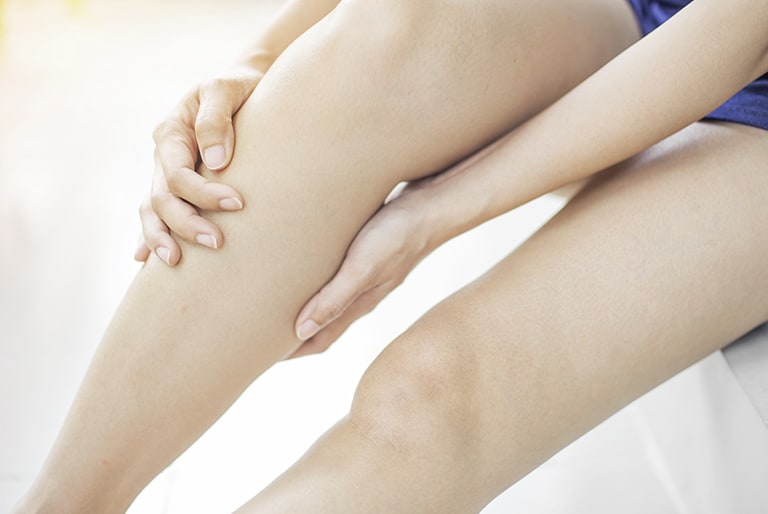Water in the legs
In summer, long periods standing and warm temperatures cause water to quickly collect in your legs. What appears harmless can have serious causes. Frequently, such water retention masks a disease of the veins or the lymphatic system which must be treated.

What is meant by water in the legs?
Where does water in the legs come from?
The body of an adult is made up of 70% water. Fluids are found in both cells as well as in the intercellular spaces and blood vessels, and they are normally in a balanced state. The lymphatic system undertakes the removal of the fluids to the veins. The venous system then conveys the blood to the heart.
But sometimes this transportation flow gets into a mess due to altered pressure ratios in the body, or a functional disorder of the veins or lymphatic vessels, and water collects in your legs. There are several reasons for that:
- Oedemas can form in the legs through sitting or standing for long periods. Quite often, such accumulations of water are harmless and dissolve through more movement or by putting your feet up.
- In summer, the vessel walls expand due to the high temperatures, which can also lead to a build-up of fluids.
- Often venous insufficiency is the cause of water in the legs. If your venous valves do not function well enough they cannot correctly prevent the blood which has been transported upwards from flowing back down. Water retention can also be caused by varicose veins, vein inflammation or vein thrombosis.
- Water in the legs can also be caused by a disorder in the lymphatic system. In a so-called lymphoedema the fluid collects mainly in your feet, toes and ankles. Quite often it results from cancers and their treatment.
- Heart failure impairs the pump capacity of your heart muscle. The reduced pressure cannot compete with gravity and the fluids build up. Arterial diseases can also foster oedemas.
- Women, in particular, often suffer from water in the legs. That is due to hormonal changes which occur during pregnancy, during the menopause or simply every month as part of the menstrual cycle.
- Alcohol and medicines, e.g. cortisone preparations or painkillers, can also encourage the development of oedemas.
Water in the legs often mask quite different diseases. If you often suffer from oedemas you should definitely consult a doctor, in order to clarify the causes and to treat them.
How bad is water in the legs?
If the water retention disappears within 24 hours and only occasionally returns, it is usually harmless and due to hot weather or sitting too long. But oedemas in the legs could also be a warning of different diseases, which should always be clarified by a doctor. For example, they could be an initial indication of a cardiovascular disease or a pulmonary oedema, which could be dangerous if left untreated. In such cases, self-help measures such as cooling your legs and putting your feet up are not enough on their own. Only an appropriate therapy can stop or slow down the advance of the disease.
If swelling suddenly appears in both legs or one leg, accompanied by other symptoms such as skin that is hot to the touch, fever, respiratory problems or pains in the chest, it could be a case of vein thrombosis or even pulmonary embolism. Call the emergency doctor immediately, – it could be a matter of life or death!
What can I do against water retention?
Sport and movement are usually enough to alleviate swollen legs after a long day in the office. Here are some more tips and possible therapies:
- Cooling: treading in cold water and cooling compresses ensure that your vessels contract and that circulation is stimulated.
- Take the strain off your legs: place your feet on a chair or lie on your back and stretch your legs in the air: that helps the accumulated fluids to flow away more easily.
- Encourage blood flow: drink enough fluids, at least two litres of water or tea per day. That helps the blood to flow more easily through your veins. Medicines like Veno SL® 300 have a similar effect. The active ingredient they contain, Troxerutin, is extracted from a substance from the Japanese Pagoda Tree. It supports your vessel walls and improves the fluidity of your blood.
- Compression therapy: your vein function is intensified by the pressure from compression stockings and with that so too is the removal of retained water.
- Lymphatic drainage: a gentle massage along the lymphatic channels stimulates your lymph circulation towards the heart and water flows out of your legs.
How can I remove water from my body?
Diuretic foodstuffs and herbal teas can be useful to quickly remove water from your legs:
- Cucumbers
- Asparagus
- Pineapples
- Strawberries
- Melons
- Rice
- Nettle tea
- Birch leaf tea
- Dandelion tea
- Ginger tea
- Green tea
You should simultaneously drink a lot and avoid alcohol, coffee and salt. If household remedies against water retention are not enough on their own, your doctor can prescribe diuretic medicines.



